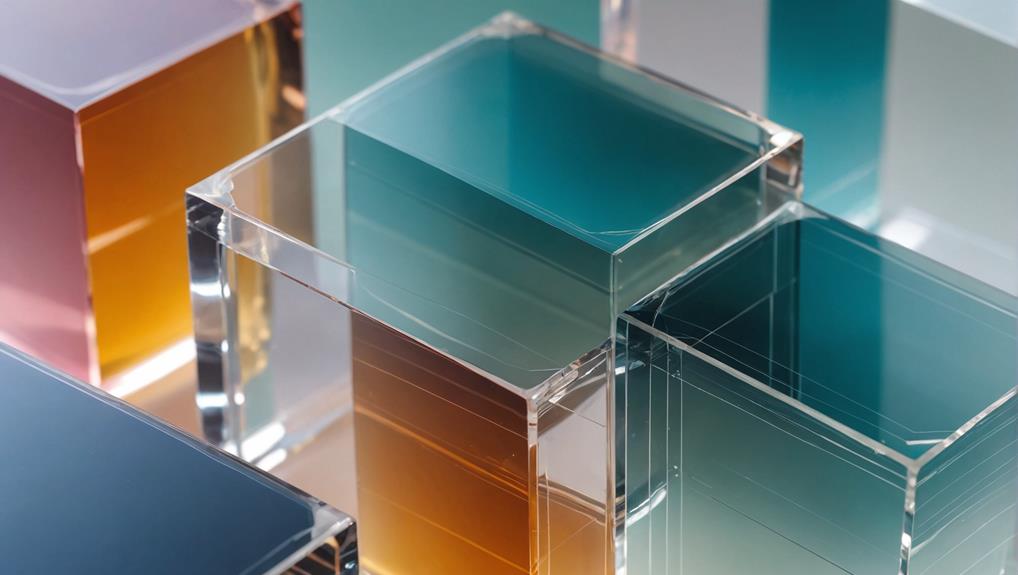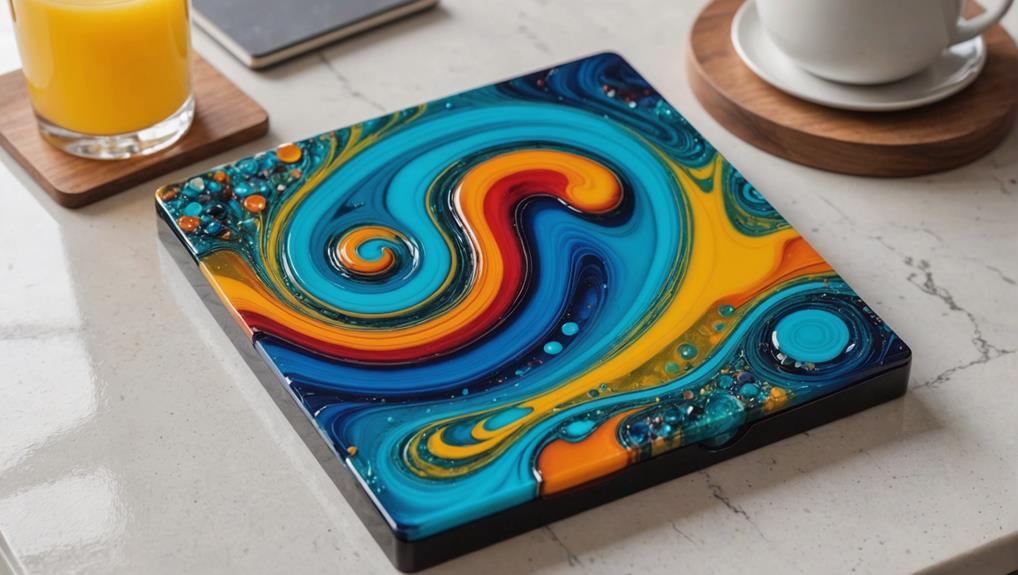Resin art’s weight can range quite a bit depending on several factors, like the type of resin and how thick you pour it. Epoxy resins, which are common, are denser than water and can make for some hefty art. Imagine a gallon of water weighs about 8 pounds; a gallon of epoxy resin can weigh up to 11 pounds! So, if you layer it thick, your piece can get pretty heavy. Oh, and if you add stuff like metallic powders or glass, it packs on even more weight. Now, don’t you want to find out just how much more there is to it?
Key Takeaways
- The weight of resin art depends on the density of the epoxy resin, typically ranging from 1.1 to 1.2 g/cm³.
- A gallon of epoxy resin weighs between 9 to 11 pounds, heavier than water’s 8.3 pounds per gallon.
- Thicker resin layers increase the artwork’s weight, with a 1 cm layer potentially weighing 11 to 12 kg.
- Additives and fillers like metallic powders and glass beads contribute significantly to the overall weight.
Understanding Resin Art Weight
Understanding the weight of resin art necessitates a thorough examination of the material’s density and its application thickness.
Resin weight plays a significant role in how an artwork feels and looks. Imagine holding a piece of art that feels like it weighs as much as a small cat—it’s all about that resin! Most epoxy resins used in art have a density between 1.1 and 1.2 g/cm³, making them about 16% denser than water. This means that even a thin layer of resin can add noticeable heft to an artwork.
Now, let’s talk gallons! A gallon of epoxy resin weighs between 9-11 pounds, compared to just 8.3 pounds for a gallon of water. That’s quite a difference, right? If you use a filled epoxy resin, the weight can jump even more, making the resin up to 70% heavier than water.
Thickness also matters. A thicker resin layer means a heavier art piece, which can affect artwork balance. So, if you’re planning to hang your resin art, make sure your wall hooks are up to the task!
Accurate measurement of the resin mixture is key to keeping the weight and performance consistent. One tiny mistake can throw off the whole balance!
Density of Epoxy Resin
Let’s talk about the density of epoxy resin, which is a key factor in how heavy your resin art will be.
Epoxy resins usually have a density between 1.1 and 1.2 grams per cubic centimeter, meaning they’re heavier than water but lighter than concrete.
Different factors like the type of formulation and the curing agent can change the density, so not all resins weigh the same.
Epoxy Resin Density Range
The density of epoxy resin typically ranges from 1.1 to 1.2 g/cm³, making it approximately 16% denser than water. This means that if you had a container of epoxy resin and one of water, the resin would be heavier. This density range is one of the key epoxy resin properties that influences how it’s used in art and construction.
When you’re comparing resin weight to other materials, it’s important to note that:
- Epoxy resin weighs around 9 to 11 pounds per gallon, while water weighs about 8.3 pounds per gallon.
- Filled epoxy resins (those with added materials) can be even denser, reaching up to 1.7 g/cm³, which is considerably heavier.
Understanding these differences is vital when you’re planning a resin art project. You wouldn’t want your beautiful resin sculpture to sink like a stone if it’s too heavy, right?
Also, knowing the resin weight comparison helps you decide how much material you need without breaking the bank or your back! So, keep these numbers in mind next time you’re working on your masterpiece.
Factors Affecting Resin Density
Several factors contribute to the density of epoxy resin, including specific formulations, choice of curing agents, and mixing ratios.
Imagine you’re about to create a masterpiece using resin applications or artistic techniques. The density of your resin can make a big difference! Most epoxy resins range from 1.1 to 1.2 g/cm³, which is about 16% denser than water. But wait, it doesn’t stop there. Filled epoxy resins can get up to a whopping 1.7 g/cm³, making them 70% heavier than water. That’s like comparing a feather to a rock!
Now, the specific formulation of the resin you choose is vital. Different brands and types have unique ingredients that can change the weight.
Then, there’s the choice of curing agents. Think of them as the resin’s best friends who help it harden. Pick the wrong friend, and you might end up with a heavier or lighter mixture than you planned.
Mixing ratios are another key player. If you mess up the resin-to-hardener ratio, your final piece might be off-balance.
And don’t forget, the thickness of the resin layer you apply will also affect the overall weight of your artwork. So, measure carefully and layer wisely!
Resin Formulation Impact
Formulation choices, including the type of resin and curing agent, play an essential role in determining the weight and density of resin art. Different resin types have varying densities, affecting the overall heaviness of the finished piece.
For example, epoxy resins generally have densities ranging from 1.1 to 1.2 g/cm³, making them about 16% denser than water. The curing agents used can also influence the final weight, with some formulations leading to heavier or lighter outcomes.
The choice of additives and fillers in the resin mixture can further modify the weight and density. These components can considerably alter the final product, sometimes increasing the density up to 1.7 g/cm³. This makes filled epoxy resins nearly 70% heavier than standard epoxy resins, adding considerable heft to the artwork.
- Epoxy Resins: Known for their higher density, typically ranging between 1.1 and 1.2 g/cm³.
- Curing Agents: Different agents can affect the final weight, with some producing lighter or heavier results.
Understanding these formulation impacts is essential for artists aiming to achieve specific weight characteristics in their resin art creations.
Mixing Ratios and Weight
Accurately measuring the mixing ratios of resin and hardener is critical for achieving the desired weight and consistency in resin art. Imagine you’re baking a cake: too much flour or too little sugar, and it’s a disaster. Resin art is no different. The typical mixing ratio for epoxy resin is 100 parts resin to 66 parts hardener by weight. Get this wrong, and your art could end up too heavy or not set properly.
Now, let’s talk mixing techniques. You can use a scale for pinpoint precision or measuring cups for a more visual approach. Either way, make sure you’re spot on. Even a tiny mistake can mess up your weight calculations and the final look of your piece.
The thickness of your resin layer plays a big role, too. Thicker layers mean a heavier final product. And since the density of most epoxy resins ranges from 1.1 to 1.2 g/cm³, the volume you use is key. Picture stacking bricks: more bricks, more weight.
Additives and Fillers

Having established the importance of precise mixing ratios, it is now essential to contemplate how additives and fillers influence the weight and characteristics of resin art.
Additives and fillers can really change things up, making resin pieces heavier, stronger, and even more interesting to look at. Imagine adding little bits of magic to your resin mix!
Different additive types, like metallic powders, silica, and glass beads, can make your artwork pop with unique textures and colors. But beware—these additives also make your resin heavier. For example, fillers like glass beads can greatly increase the density of your resin, making it potentially 70% heavier than water!
Here are some ways fillers can change your resin art:
- Weight: Heavier fillers like metallic powders boost the overall weight, making your piece feel sturdy and substantial.
- Texture: Fillers like silica add interesting textures, making your art not just a visual experience but a tactile one too.
Accurate measurement of these fillers is vital. Too much or too little can mess up your final product’s weight and strength.
Measuring Resin Weight
Measuring resin weight involves understanding its density and how the formulation affects it.
The mixing ratios are essential, especially with ART PRO Clear Resin’s specific 100:66 weight ratio.
Also, the thickness of the resin layer can change the overall weight, which impacts how the final piece performs and looks.
Density and Formulation Impact
The density and formulation of epoxy resin are essential factors that influence its overall weight and performance characteristics. Understanding these elements can help artists create pieces that are not only visually stunning but also structurally sound.
Density variations in epoxy resins are primarily due to their chemical composition. Most epoxy resins have a density ranging from 1.1 to 1.2 g/cm³, making them about 16% denser than water. However, filled epoxy resins can have densities up to 1.7 g/cm³, which makes them considerably heavier.
Formulation effects also play an important role in determining the weight of the resin. Different formulations and curing agents can alter the density and overall weight of the resin.
For instance:
- Standard epoxy resins: Typically range from 9 to 11 lbs per gallon.
- Filled epoxy resins: Can be up to 70% heavier than water, reaching densities up to 1.7 g/cm³.
Mixing Ratios Importance
Accurate mixing ratios are vital in resin art to secure the structural integrity and aesthetic quality of the final piece. Imagine baking a cake but forgetting the correct amount of flour or eggs—disaster, right? The same goes for resin art. The ART PRO Clear Resin, for instance, requires a specific mixing ratio of 100:66 by weight. Getting this ratio wrong can mess up the entire project, leading to issues like poor curing and unwanted textures.
Using precise mixing techniques guarantees that your resin art turns out just as you envisioned. Having ratio accuracy is like having a superpower in the resin world. Even a tiny mistake in measuring the components can affect the final weight, strength, and adhesion properties of your art piece.
And let’s not forget, the weight of the resin mixture can change considerably based on the additives and fillers you use. This means that following the recommended mixing guidelines is vital not only for the look but also for the performance of your artwork.
Consistently measuring your materials helps keep your project cost-effective, too. You avoid wasting expensive resin and guarantee that every drop counts toward creating something beautiful and durable.
Layer Thickness Considerations
Layer thickness directly impacts the overall weight and structural integrity of resin art, necessitating meticulous measurement to guarantee desired outcomes. Imagine pouring a thick layer of syrup over a pancake. The thicker the syrup, the heavier the pancake becomes. The same goes for resin art. The thicker the layer of resin, the more it weighs, which can affect how sturdy and balanced your art piece is.
For example, a gallon of epoxy resin can weigh between 9 to 11 pounds. If you apply it thickly, the weight adds up quickly.
Here’s what you need to keep in mind:
- Volume Matters: Measure the dimensions of your art piece accurately to calculate the right volume of resin needed.
- Density Counts: Most epoxy resins have a density of 1.1 to 1.2 g/cm³. This means the thicker the layer, the heavier it will be.
Layer Thickness Considerations

Understanding the impact of layer thickness is essential for resin artists aiming to balance aesthetic appeal with practical considerations like weight and structural integrity.
When deciding on the thickness of resin layers, artists must consider both layer aesthetics and structural balance. Thicker layers can create a stunning, three-dimensional effect that adds depth to the artwork, enhancing its visual appeal. However, this beauty comes at a cost—literally and figuratively.
Typical epoxy resin has a density ranging from 1.1 to 1.2 g/cm³, which means that even a 1 cm thick layer over a square meter surface area can weigh between 11 to 12 kg. Imagine how heavy it gets with multiple layers! Each additional layer not only adds to the weight but also demands careful calculations to guarantee the piece remains structurally sound. No one wants their masterpiece to bend or break, right?
Artists must also think about how their art will be displayed. Heavier pieces might need stronger supports. So, while those thick layers can make your art look amazing, you need to balance them with practical concerns.
Display and Transportation
When displaying and transporting resin art, you’ll need to find secure hanging methods and portable display solutions.
Heavy resin pieces require strong supports like large D ring hangers or sturdy gallery systems to keep them safe.
For smaller pieces, clear or colored stands can make them look great while being easy to move around without risking damage.
Secure Hanging Methods
For maximum security when displaying heavy resin art, utilize aircraft cable in place of standard picture wire to confirm greater strength and stability. This is one of the best hanging techniques to ascertain your artwork remains securely fastened to the wall, enhancing wall safety and preventing accidental falls.
When preparing to hang your resin art, consider these key points:
- Use large D ring hangers: These provide a sturdy anchor for the aircraft cable, confirming that the artwork remains firmly attached to the wall.
- Check screw length: Before installation, verify screws are the correct length to avoid penetrating and damaging the artwork.
These methods provide a robust framework for safely displaying your resin art. The importance of wall safety cannot be overstated when dealing with heavy pieces.
Imagine the horror of a cherished artwork crashing down because of inadequate support! By following these guidelines, you can avoid such mishaps and keep your resin masterpieces securely in place.
Portable Display Solutions
Given the varying weights of resin art pieces, employing portable display solutions that provide both stability and ease of transportation is crucial for artists and exhibitors.
Imagine lugging a heavy resin table to an art show—no easy task! That’s why using lightweight materials like marine plywood in the base is a smart move. It keeps your piece sturdy but makes it easier to carry.
Now, let’s talk about displaying these beauties. If you’re using shelves, clear or colored display stands can do wonders. They not only support the weight but also make your art pop, enhancing its visibility and overall charm. It’s like giving your art a little stage to shine on!
For those larger, heavier pieces, you’ll want something more robust. Heavy-duty art gallery systems or ceiling hooks come to the rescue here. They guarantee your art stays put and doesn’t end up crashing down—yikes, what a disaster that would be!
Always remember to check your display setups regularly. You don’t want any surprises with a stand giving out. With the right portable display solutions and a few aesthetic considerations, your resin art will be both safe and stunning wherever you take it!
Safety and Handling
Guaranteeing safety while handling resin art requires consistent use of protective clothing, gloves, and safety goggles to prevent skin contact and eye injuries. These safety precautions are vital because resin can be pretty nasty if it gets on your skin or in your eyes. Not to mention, inhaling the fumes during the mixing and curing process can be harmful. So, make certain your workspace is well-ventilated to keep those fumes at bay.
Handling techniques are also essential. When you’re dealing with resin art, you need to be mindful of its weight. Epoxy resin is denser than water, which means it can be heavier than you might expect. This can make lifting and carrying larger pieces tricky. Always use proper lifting techniques to avoid straining your back or dropping your masterpiece.
Here’s a quick checklist to keep you on track:
- Ventilation: Guarantee your workspace is well-ventilated to avoid inhaling harmful fumes.
- Disposal: Properly dispose of waste materials like unused resin and mixing containers to minimize environmental hazards.
Curing Time and Weight
Understanding the curing time and weight of resin art is imperative for achieving a successful and durable finished product.
The curing time, or catalysis duration, for resin art usually ranges from 24 to 72 hours for initial hardening. However, achieving full catalysis can take between 7 to 10 days, depending on the specific epoxy formulation used. This extended period is essential for ensuring the resin reaches its maximum strength and stability.
Weight measurements are another important aspect to take into account. Epoxy resin‘s density typically ranges from 1.1 to 1.2 g/cm³, making it about 16% denser than water. For instance, a gallon of epoxy resin weighs between 9 to 11 pounds.
Artists often use packages of resin weighing around 8.3 kg, or 18.29 pounds, which is standard for most artistic applications. The thickness of the resin layer also plays a significant role in determining the final weight of the piece, with thicker applications resulting in heavier artworks.
Accurate measurement of resin components is essential. Even minor deviations can lead to inconsistencies in both weight and curing performance.
Therefore, precise weight measurements and adherence to curing times are fundamental to producing high-quality resin art.
Applications of Resin Art

Building on the importance of curing time and weight measurement, resin art finds a multitude of applications in creating both decorative and functional items. This versatile art form allows creators to experiment with various resin art techniques, making each piece unique and enchanting. The possibilities are seemingly endless, thanks to the transparent and self-leveling properties of epoxy resin, which can be used to achieve stunning 3D effects and fluid-art techniques.
Resin art is commonly used for:
- Decorative applications: Coasters, trays, and wall art that add a glossy, durable finish to any space.
- Surface coatings: Enhancing the color depth and brilliance of countertops and furniture, making them stand out.
The lightweight nature of cured resin art makes it easy to handle and display, whether as free-standing pieces or as part of larger installations.
Because of its durability, resin art is perfect for both indoor and outdoor decorative applications. Artists can explore endless creative possibilities, adding a unique touch to any project while ensuring longevity and aesthetic appeal.
Frequently Asked Questions
Is Resin Art Heavy?
The weight of resin art depends on the resin density and specific additives used. Generally, the art weight varies due to the formulation and thickness, with most epoxy resins being manageable and considerably lighter than materials like concrete.
Is Resin Material Heavy?
Resin material can vary in weight depending on its density. Epoxy resins typically have a density of 1.1 to 1.2 g/cm³, resulting in resin weight that is generally heavier than water but lighter than concrete.
Are Resin Statues Heavy?
Resin statues can indeed be heavy, primarily due to the resin density, which ranges from 1.1 to 1.7 g/cm³. Consequently, substantial statue weight is expected, especially with larger or thicker designs utilizing filled epoxy resins.
Is Resin Heavier Than Wood?
In a resin density comparison, resin is generally heavier than wood, particularly lighter types like pine. Wood weight characteristics vary, but epoxy resin’s density of 1.1 to 1.2 g/cm³ often surpasses that of many common woods.
Conclusion
Resin art’s weight is influenced by several factors, including the density of epoxy resin, the formulation used, and the mixing ratios.
Additives and fillers can further alter the weight.
Proper display and transportation are essential for managing the often substantial weight of resin art pieces.
Safety, handling, and curing time also affect the final weight.
Understanding these elements is fundamental for artists and enthusiasts who wish to create, display, or transport resin art effectively.


Leave a Reply